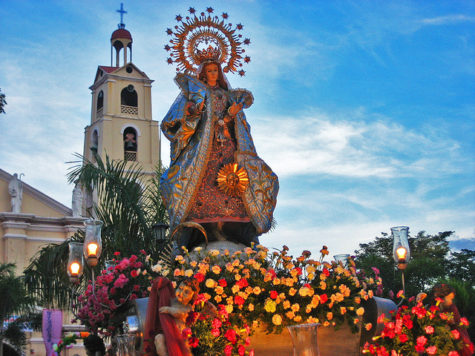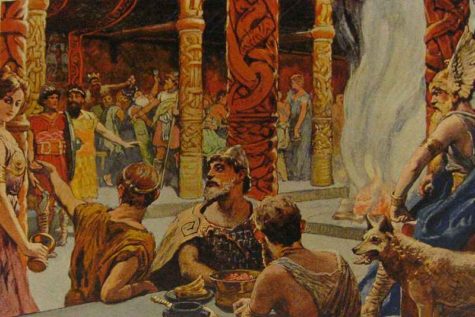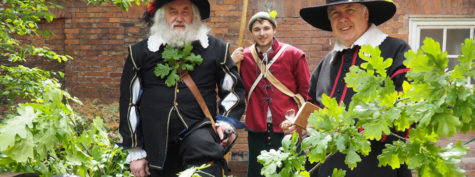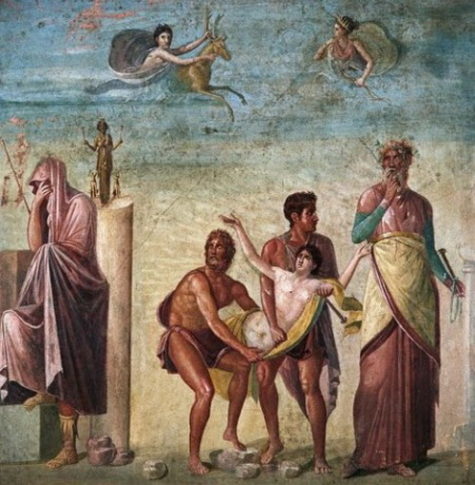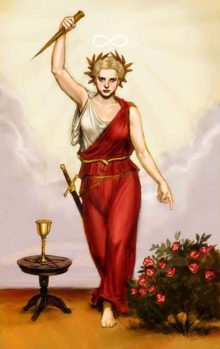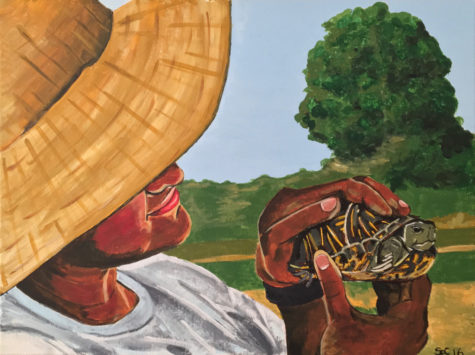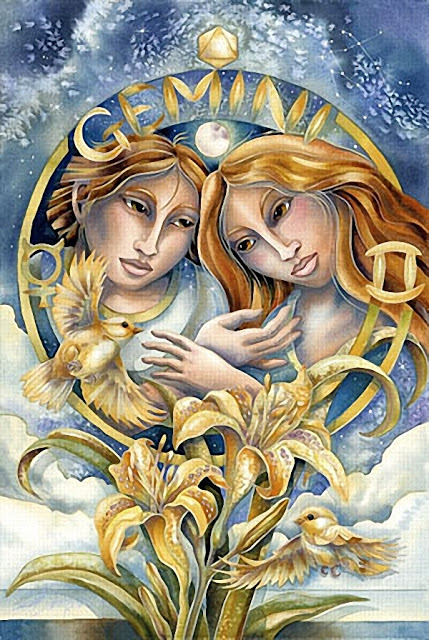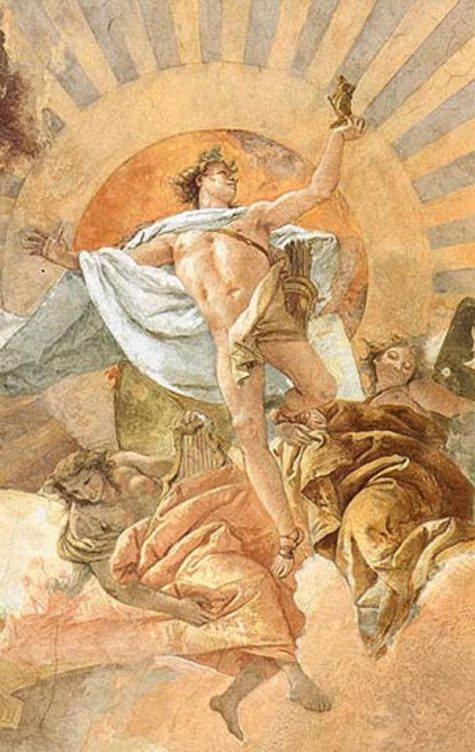Monthly Archives: May 2017
Flores de Mayo (Spanish for “flowers of May”) is a festival held in the Philippines in the month of May. It is one of the May devotions to the Blessed Virgin Mary and lasts for the entire month.
The Santacruzan (from the Spanish santa cruz, “holy cross”) is the ritual pageant held on the last day of the Flores de Mayo. It honors the finding of the True Cross by Helena of Constantinople (known as Reyna Elena) and Constantine the Great. Its connection with May stems from the old May 3 date of Roodmas, which Pope John XXIII abolished in 1960 in favour of the Feast of the Exaltation of the Cross on September 14
Regional Celebrations:
- In the Bicol Region, the ritual begins with the recitation of the rosary, and the last day is simply called the “katapusan”.
- In Western Visayas, the towns have their respective chapels where an image of the Virgin Mary is venerated and children gather to have a simple catechism and teachings about the life and story of Mary. They were also taught some prayers and songs recited only during the Flores de Mayo and the children offer flowers before the image of the Virgin Mary as a symbol of love, affection and veneration.
- Some churches and areas give children paper tickets for actively participating during the catechism and at the end of the month of May, the children redeem the value of the tickets which are school supplies ready for the school opening in June. Santacrusan is usually held during the last few days of May to coincide with the end of the catechism for children.
- Amongst the Tagalog people, the custom began after the publication of Mariano Sevilla’s translation of the devotional “Flores de María” or “Beautiful Flowers that in the Meditations in the Whole Month of May are Offered by Devotees to Mary Most Holy.”
- One famous May tradition in Batangas is the Luglugan, or nightly devotion and party honoring the Virgin Mary. Held in structures called tuklóng, devotees offer flowers and prayers to an image of Mary every night. After the prayer, the Hermanos or Hermanas for the day will give away treats to the participants, followed by the party. The Luglugan lasts for a month until the Tapusan (“ending”) which is marked with a Mass, a Santacruzan and procession of the Blessed Virgin Mary, and capped with a final Luglugan that lasts until the following morning.
- A Santacruzan is a religio-historical beauty pageant held in many cities, towns, and even in small communities throughout the Philippines during the month of May.
The Santacruzan Procession and Pageant
 One of the most colorful aspects of this festival, the pageant depicts the finding of the True Cross by Queen Helena, mother of Constantine the Great. Many movie and television personalities participate in the events and are featured in major santacruzan. This festival became part of Filipino traditions identified with youth, love, and romance.
One of the most colorful aspects of this festival, the pageant depicts the finding of the True Cross by Queen Helena, mother of Constantine the Great. Many movie and television personalities participate in the events and are featured in major santacruzan. This festival became part of Filipino traditions identified with youth, love, and romance.
Prior to the Santacruzan, a novena is held in honor of the Holy Cross. The procession itself commemorates the search of the Holy Cross by Reyna Elena and her son, Emperor Constantine. It is said to have roots in the joyous thanksgiving celebrations that followed the finding of the Holy Cross in Jerusalem and its translation to Constantinople (now İstanbul).
The procession is accompanied by the steady beat of a local brass band, playing and singing the Dios te salve (the Spanish version of the Hail Mary). Devotees hold lighted candles and sing the prayer as they walk. It is customary for males participating in the Santacruzan to wear the traditional Barong Tagalog and that the females wear any Filipiniana-inspired dress.
After the procession in some places, there is the pabítin game (in Cavite, it is called “agaw-bitin”) that serves as a culminating activity for the children. The pabítin is a square-shaped bamboo grille or frame to which goodies (candies, fruits, small trinkets, etc.) are tied with thin strings.
This grille in turn is tied to a long rope passed over a strong branch or pole some 2 metres above the ground. Children then gather under the frame as the it is slowly lowered, and they then jump as high as they could to grab the goodies while someone jerks it up and down repeatedly until all the prizes are gone.
Sometimes the palosebo (the local version of the greasy pole) is also played, where a tall bamboo pole is smeared with grease which participants must climb to get a small red banner or a bag with a prize, such as ₱500 or a higher amount.
For a Magickal Flores de Mayo
 From 360 Goddess, we have a different version of, and way to celebrate the Flores de Mayo. This can be celebrated any time during the month of May, or on the last day, as a sort of magickal Santacruzan.
From 360 Goddess, we have a different version of, and way to celebrate the Flores de Mayo. This can be celebrated any time during the month of May, or on the last day, as a sort of magickal Santacruzan.
- Themes: Offering; Prayer; Love; Devotion; Home; Relationships
- Symbols: Spring; May Blossoming Flowers
- Presiding Goddess: Sisina
About Sisina:
This Filipino goddess oversees the realms of orderliness, beauty, and love. Traditionally, she protects marriages against discord, but she may also be called upon to settle inner turmoil within your soul and restore self-love.
To do today:
People in the Philippines say good-bye to May with bouquets, flower offerings, and an array of sweet foods to honor the month’s sweetness and beauty. Sometimes they ask Sisina to join the festivities by setting a place for her at the table.
This particular custom appears in several other cultures and it is a simple, lovely way of honoring the goddess. Just leave a plate with a fresh flower on your dinner table. This draws Sisina’s presence, love, and peaceful nature to your home and family relationships. If you wish, also leave an offering of sweet bread or fruity wine in a special spot to thank her.
As you go about your normal routine today, take time to enjoy any flowers you see, and be very considerate of the special people in your life. Sisina will see the effort and continue blessing those relationships with harmony.
Sources: 365 Goddess and wikipedia
Memorial Day is the day meant to be set aside to specifically honor the war dead. As such, it is an appropriate day to observe rituals to honor the Einherjar: the battle-slain warriors who are taken to Valhalla.
Who are the Einherjar? They are an army of all men who fall in battle, they are adopted as Odin’s sons. He allots to them the halls Valhalla and Vingólf. There they await Ragnarok, when they will join the Gods in fighting the Giants. They spend most of their time fighting, eating, and drinking.
Of course, not all of the battle-slain go to Valhalla some also go to Freya’s Hall, but many modern pagans will honor the war-dead, especially their ancestors who served at this time.
Others will honor the Einherjar on Veteran’s Day instead, even though, technically Veteran’s Day is intended to first and foremost honor those living Veterans from past military service, it is also used to honor those currently serving, and to a lesser degree those soldiers now dead.
For more about the Einherjar – read on…
In Norse mythology, the Einherjar (Old Norse “lone fighters”) are those that have died in battle and are brought to Valhalla by Valkyries. In Valhalla, the Einherjar eat their fill of the nightly-resurrecting beast Sæhrímnir, and are brought their fill of mead (from the udder of the goat Heiðrún) by Valkyries. The Einherjar prepare daily for the events of Ragnarök, when they will advance for an immense battle at the field of Vígríðr.
“Valholl is widely spread out;
here Odin chooses every day
weapon-slain warriors…”
In Norse cosmology, those that die in battle hold a special role within Asatru. They are the Einherjar, those that are chosen by Odin to fight on the side of the Gods at Ragnorak. (see explanation below)
Accounts of Valhalla describe it as a large hall, decked with the implements of battle. The Einherjar are described as being well-hosted, they are fed on pork and mead, and each day, the Einherjar practice at the art of battle. They engage one another in terrible, bloody conflicts, and at the end of the day, come back to life, and walk off the field, the best of friends.
All the Einheriar fight in Odin’s courts every day;
they choose the slain and ride from battle;
then they sit more at peace together.
It seems probable that historically, the Einherjar could be best described as some sort of “elite” troops, and that going to Valhalla was not necessarily the fate of the common soldier. Odin was traditionally followed by members of the ruling classes, not by ordinary folk. Adding to this the idea of the Einherjar fighting day after day, and enjoying it immensely does seem more in line with an elite unit, it seems likely that an ordinary draftee might get a little tired of day after day of fighting.
In actual modern-day practice, Einherjar blot has tended to become a day to honor all of those who die in wars, and to a lesser extent, veterans in general. How exactly does one reconcile these two different images of the Einherjar? One thing is clear, it was never a part of old Norse thought to hold to one view of the afterlife. Where you ended up after your death seemed reliant on which Gods you followed in life, and what sort of person you were.
Hail those that serve!
Hail the fallen!
Hail the Einherjar!
Note:
In Norse mythology, Ragnarök (Old Norse “final destiny of the gods”) is a series of future events, including a great battle foretold to ultimately result in the death of a number of major figures (including the gods Odin, Thor, Týr, Freyr, Heimdall, and Loki), the occurrence of various natural disasters, and the subsequent submersion of the world in water.
Afterward, the world will resurface anew and fertile, the surviving and reborn gods will meet, and the world will be repopulated by two human survivors.
Sources: Wikipedia and Raven Kindred
Oak Apple Day or Royal Oak Day was a formal public holiday celebrated in England on 29 May to commemorate the restoration of the English monarchy, in May 1660. Parliament declared this to be a public holiday, “to be for ever kept as a day of thanksgiving for our redemption from tyranny and the King’s return to his Government, he entering London that day.”
People wore sprigs of oak and decorated homes, boats, barns and (latterly) even railway engines. There was dancing, maypoles, and the streets were hung with oak branches. Anyone who failed to wear a sprig of oak risked being pelted with bird’s eggs or thrashed with nettles. In Sussex, those not wearing oak were liable to be pinched, giving rise to the unofficial name of “Pinch-bum Day”; similarly it was known as “Bumping Day” in Essex.
The Chelsea Pensioners still wear oak leaves on their Founders Day (which is always as close as possible to 29th May) as the Royal Hospital of Chelsea was founded by Charles II. They also decorate the statue of Charles II there with oak leaves and branches.
In Upton Grey, Hampshire, after the church bells had been rung at 6 a.m. the bell-ringers used to place a large branch of oak over the church porch, and another over the lych gate. Smaller branches were positioned in the gateway of every house to ensure good luck for the rest of the year.
These ceremonies, which have now largely died out, are perhaps continuations of pre-Christian nature worship.
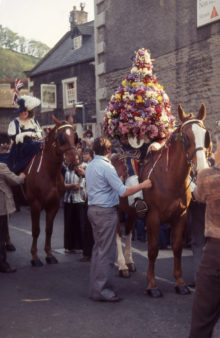 The Garland King who rides through the streets of Castleton, Derbyshire, at the head of a procession, completely disguised in a garland of flowers which is later affixed to a pinnacle on the parish church tower, can have little connection with the Restoration, even though he dresses in Stuart costume.
The Garland King who rides through the streets of Castleton, Derbyshire, at the head of a procession, completely disguised in a garland of flowers which is later affixed to a pinnacle on the parish church tower, can have little connection with the Restoration, even though he dresses in Stuart costume.
He is perhaps a kind of Jack in the Green and the custom may have transferred from May Day when such celebrations were permitted again after having been banned by the Puritans.
The public holiday, Oak Apple Day, was formally abolished by the Anniversary Days Observance Act 1859, but the date retains some significance in local or institutional customs.
Events still take place at Upton-upon-Severn in Worcestershire, Aston on Clun in Shropshire, Marsh Gibbon in Buckinghamshire, Great Wishford in Wiltshire (when villagers gather wood in Grovely Wood), and Membury in Devon. The day is generally marked by re-enactment activities at Moseley Old Hall, West Midlands, one of the houses where Charles II hid in 1651.
Fownhope, Hereford have an ongoing tradition in the celebration of Oak Apple Day. The Fownhope Heart of Oak Society organize an annual event, where members of the society gather at the local pub and march through the village holding flower and oak leaf decorated sticks, whilst following the society banner and a brass band. The march goes first to the church for a service, and then to houses who host refreshments.
The Heart of Oak Society was previously a friendly society, but had to reform in 1989 to keep the tradition going. Although Oak Apple Day celebrations have decreased in popularity and knowledge, Fownhope has managed to keep the event going, increasing in popularity and turn-out every year.
At All Saints’ Church, Northampton a statue of Charles II is wreathed at noon every Oak Apple Day, followed by a celebration of the Holy Communion according to the Book of Common Prayer.
At some Oxford and Cambridge colleges a toast is still drunk to celebrate Oak Apple Day.
Oak Apple Day is also celebrated in the Cornish village of St Neot annually. The Vicar leads a procession through the village, he is followed by the Tower Captain holding the Oak bough. A large number of the villagers follow walking to the Church. A story of the history of the event is told and then the Vicar blesses the branch. The Tower Captain throws the old branch down from the top of the tower and a new one is hauled to the top.
Everyone is then invited to the vicarage gardens for refreshments and a barbecue. Up to 12 noon villagers wear a sprig of “red” (new) oak and in the afternoon wear a sprig of “Boys Love” (Artemisia abrotanum); tradition dictates that the punishment for not doing this results in being stung by nettles.
What is an Oak Apple?
An oak apple is a mutation of an oak leaf caused by chemicals injected by the larvae of certain kinds of gall wasp laying an egg which becomes a larva inside the gall. In some parts of the country it is known as a “shick-shack.”
Oak apples (or galls) were also used to divine the future or to check if a child had been bewitched. Some of the meanings of what was found inside are as follows:
- An ant – plenty of grain to come
- A spider – ‘pestilence among men’
- A white worm or maggot – ‘murain of beasts’
- A flying worm – war
- A creeping worm – a scarce harvest
- A turning worm – plague
People would also wear oak bark and galls woven into balls as healing charms.
Source: Wikipedia
Memorial Day is a federal holiday in the United States for remembering the people who died while serving in the country’s armed forces. The holiday, which is currently observed every year on the last Monday of May, originated as Decoration Day after the American Civil War in 1868, when the Grand Army of the Republic, an organization of Union veterans founded in Decatur, Illinois, established it as a time for the nation to decorate the graves of the Union war dead with flowers.
By the 20th century, competing Union and Confederate holiday traditions, celebrated on different days, had merged, and Memorial Day eventually extended to honor all Americans who died while in the military service. It marks the start of the unofficial summer vacation season, while Labor Day marks its end.
Many people visit cemeteries and memorials, particularly to honor those who have died in military service. Many volunteers place an American flag on each grave in national cemeteries.
Annual Decoration Days for particular cemeteries are held on a Sunday in late spring or early summer in some rural areas of the American South, notably in the mountain areas. In cases involving a family graveyard where remote ancestors as well as those who were deceased more recently are buried, this may take on the character of an extended family reunion to which some people travel hundreds of miles.
People gather on the designated day and put flowers on graves and renew contacts with relatives and others. There often is a religious service and a picnic-like “dinner on the grounds,” the traditional term for a potluck meal at a church. It is believed that this practice began before the American Civil War and thus may reflect the real origin of the “memorial day” idea.
Memorial Day is not to be confused with Veterans Day. Memorial Day is a day of remembering the men and women who died while serving, while Veterans Day celebrates the service of all U.S. military veterans.
A magickal ritual from The Pagan Book of Hours might be appropriate for today. Here is is:
Feast of the Fallen Warriors
- Color: Red
- Element: Fire
- Altar: On a red cloth place a helmet over a skull. Set out four red candles and two crossed swords.
- Offerings: Candles. Written names of fallen warriors of the past, especially in one’s family.
- Daily Meal: Simple, plain food.
Invocation to the Fallen Warriors
Your blood lies spilled
Across all the lands of the world.
You stood and faced the enemy,
Whoever they were,
And perhaps you saw yourself
In his face,
And perhaps you did not.
Perhaps you fought
To save your kin and clan,
Perhaps for greed,
Perhaps for money,
Perhaps out of loyalty
To those you followed.
Whatever the reason,
You acquitted yourselves bravely
And did what you had to do
When it seemed right.
May your spirits rest peacefully,
And know we do not forget your glory.
(Chant in wordless harmonies as the swords are unsheathed, crossed in an arch over the altar, and resheathed again. All bow to the altar and extinguish the candles.)
Sources: Pagan Book of Hours and Wikipedia
Thargelia (Greek Θαργήλια) was one of the chief Athenian festivals in honour of the Delian Apollo and Artemis, held on their birthdays, the 6th and 7th of the month Thargelion (about May 24 and May 25).
Essentially an agricultural festival, the Thargelia included a purifying and expiatory ceremony. While the people offered the first-fruits of the earth to the god in token of thankfulness, it was at the same time necessary to propitiate him, lest he might ruin the harvest by excessive heat, possibly accompanied by pestilence. The purificatory preceded the thanksgiving service.
The most important ritual was the following. Two men, the ugliest that could be found (the Pharmakoi) were chosen to die, one for the men, the other (according to some, a woman) for the women. Acting as scapegoats for community guilt, they were draped in figs and led through the city. before being cast out.
Hipponax of Kolophon claims that on the day of the sacrifice they were led round with strings of figs on their necks, and whipped on the genitals with rods of figwood and squills. When they reached the place of sacrifice on the shore, they were stoned to death, their bodies burnt, and the ashes thrown into the sea (or over the land, to act as a fertilizing influence). However, it is unclear how accurate Hipponax’s sixth-century, poetical account of the ceremony is, and there is much scholarly debate as to its reliability.
On the first day of the festival, a sheep was sacrificed to Demeter Chloe on the Acropolis, and perhaps a swine to the Fates, but it is generally agreed that an actual human sacrifice took place on this occasion, replaced in later times by a milder form of expiation. Thus at Leucas a criminal was annually thrown from a rock into the sea as a scapegoat: but his fall was checked by live birds and feathers attached to his person, and men watched below in small boats, who caught him and escorted him beyond the boundary of the city. Similarly, at Massilia, on the occasion of some heavy calamity (plague or famine), one of the poorest inhabitants volunteered as a scapegoat. For a year he was fed up at the public expense, then clothed in sacred garments, led through the city amidst execrations, and cast out beyond the boundaries.
After having rid the city of any ill influences on the first day of the festival, the second day begins with a joyous attitude. It follows the basic structure of any other Hellenic festival. First, there was a procession, which included children who carried the eiresione, an olive branch decorated with woolen fillets, bread, fruits, small flasks of honey, and some with oil. The children would sing the following while carrying this:
“The Eiresione brings figs and fat bread,
honey in pots, and oil to rub down,
a cup of strong wine so you go drunk to bed.”
As they moved through the city, they would collect offerings along the way. Once arriving at the temple, the offering of the first fruits of the grain harvest would begin. From the surviving texts we learn that the offering was of two types: a boiled stew of grains and seasonal vegetables, or the loaf of grain bread called the thargelos. It is from the name of the loaf that the festival takes its name. This loaf was also called eueteria, meaning “good year.”
There would also be libations, hymns, much feasting and other activities during the celebration. Singing competitions were especially popular, in which 50 men from the 10 tribes of Athens participated. All of these were done in honor of Apollo, god of purification.
For a more modern approach, we have this idea:
- Themes: Cleansing; Offering; Forgiveness; Magic
- Symbols: Ritual Tools
- Presiding Goddess: As the Greek goddess who created all sacred rituals and ceremonies, Hosia oversees this rite and directs your magical energy toward successful manifestation.
To do Today:
Follow Greek tradition and leave Hosia an offering of fruit, bread, or wheat to encourage her assistance. Next consider creating a personal ritual for cleansing or forgiveness. Hosia will guide your hand in choosing words and actions suited to the working. Alternatively, take out your ritual tools and ask for hosia’s blessing on them saying:
Hosia, these are the tools of my hand, heart, and spirit.
They symbolize the elements and the corners of creation.
Today I ask that you empower them for working magic,
and regulate their use for the greatest good.
May they always direct my energy in perfect love and trust.
So be it.
In ancient Greece, a scapegoat (often a criminal) was often identified to bear the sins for an entire community, then either sacrificed or banished into the wilderness. A way to adapt this practice is by designing an image of something you need to banish, then “driving it away” by putting it in the car and leaving it in a remote spot. As you turn away, ask the goddess Hosia to witness the rite and to empower your efforts for positive change.
Sources: Wikipedia and Pagan Pages and 365 Goddess
We hear in them about parables of being slow and plodding, steady and methodical, and occasionally obsessed with Ninjitsu, news reporters, and pizza. We are, of course, talking about Turtles! Turtles are a type of reptile that exists in many environments through the word and have found their way into literature, poetry, and parable throughout the world’s history.
The first thing to know is that even though Turtles and Tortoises are not the same thing, this day is dedicated to celebrating and protecting both. World Turtle Day, May 23, is sponsored yearly by the American Tortoise Rescue (ATR) since 2000. This annually celebrated day shines a spotlight on care, conservation and awareness of the oldest living reptiles in the world, and celebrates these noble reptiles and their place in the world. The idea is to bring attention to, and increase knowledge of and respect for, turtles and tortoises, and encourage human action to help both the common box turtle, and the ever endangered sea turtle to survive and thrive.
Turtles and Tortoises
The two are often confused. Generally, turtles live and swim in the sea while tortoises are land-based. However, scientifically, “turtle” is used to describe any member of the order Testudine, which includes both turtles and tortoises!
There are seven species of sea turtles, of which the last four are classified as endangered or critically endangered:
- Flatback sea turtle (Natator depressus)
- Olive ridley sea turtle (Lepidochelys olivacea)
- Leatherback sea turtle (Dermochelys coriacea)
- Green sea turtle (Chelonia mydas)
- Loggerhead sea turtle (Caretta caretta)
- Kemp’s ridley sea turtle (Lepidochelys kempii)
- Hawksbill sea turtle (Eretmochelys imbricata)
Turtles can be found in most of the world’s oceans, with the exception of the Arctic and Antarctic. As adults, these omnivores can measure up to between 0.61 meters and 2.7 meters (2-9 feet) in length and can weigh up to 680 kilograms (1,500 pounds). All have a carapace (hard shell) except the leatherback, which has bony plates underneath leathery skin.
There are many species of tortoise, including the now-extinct Abaco tortoise (Chelonoidis albuyorum) and the saddle-backed Rodrigues giant tortoise (Cylindraspis vosmaeri). Most species of tortoise are herbivorous, with a few exceptions eating worms and insects.
Tortoises have the longest lifespans of any animal. In fact, the oldest ever tortoise (named Tu’i Malila) recorded was given to the Tongan family in 1777 by British explorer Captain Cook and lived to a grand old age of 188.
Giant tortoises move at a very leisurely pace of 0.27 kilometers per hour (0.17 miles per hour). Although tortoises are known for giving rise to the saying “slow and steady wins the race” from the Aesop fable The Hare and the Tortoise, the fastest recorded speed of a tortoise on land is a relatively zippy 8 kilometers per hour (5 miles per hour)!
In the wild, both tortoises and turtles are at risk from illegal hunting and poaching, oil spills, artificial light from coastal cities, and non-recyclable waste. As pets, these long-living reptiles can suffer greatly from improper care and handling.
Even if you like your reptiles fighting villains in the mean streets of New York City, carrying the four elephants of the Discworld through space or kidnapping Princess Peach, we can all do our part to ensure these majestic creatures are preserved, whether as pets or in the wild.
How to celebrate Turtle Day
World Turtle Day is celebrated around the globe in a variety of ways, from dressing up as turtles or wearing green summer dresses, to saving turtles caught on highways, to research activities.
- Note: If a tortoise is crossing a busy street, pick it up and send it in the same direction it was going – if you try to make it go back, it will turn right around again.
Contact American Tortoise Rescue on Facebook, or visit their website, and find out what you can do in your area to help promote the protection of turtles. If there’s no activities in your area, work with them to find out what you can do to coordinate with local aquariums, pet stores, and nature groups to focus on the species of this reptile that live in your area.
Other things you can do include the following:
- Never buy a turtle or tortoise from a pet shop as it increases demand from the wild.
- Report the sale of any turtle or tortoise of any kind less than four inches. This is illegal throughout the U.S.
- Report cruelty or the illegal sales of turtles and tortoises to your local animal control shelter.
- Never remove turtles or tortoises from the wild unless they are sick or injured.
- Write letters to legislators asking them to keep sensitive habitat preserved or closed to off road vehicles, and to prevent off shore drilling that can lead to more endangered sea turtle deaths.
History of Turtle Day
First created in 1990 by the American Tortoise Rescue, World Turtle day recognizes that some species of our hard (and soft!) shelled friends are suffering, almost on the edge of extinction due to environmental hazards and issues with hunting and harvesting of their eggs.
American Tortoise Rescue was created by Susan Tellem and Mashall Thompson, a married pair of animal activists who had a particular passion for tortoises. We all have to have something that drives us in this life, and for these two it was bonding over animal right’s activist work. Don’t think these two are just closet hippies with an overwhelming adoration for all things shelled and scaly. Susan is deeply involved with television arts & sciences and the public relations society of America while being a partner in Tellem Grody Public Relations Incorporated. They organize charity collections and works around the world to help protect these amazing critters, and created Turtle Day to get everyone involved and spread awareness of the shrinking habitat and declining numbers of these sensitive creatures.
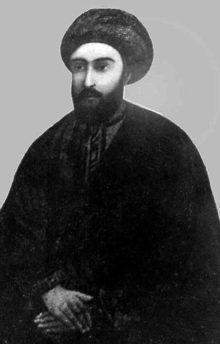 Every year during the evening of May 22 and May 23, Baha’is celebrate the Declaration of The Bab with prayers, storytelling, and reflections. It is one of the nine holy days when work is suspended. The holiday begins two hours and eleven minutes after sunset on May 22, which is the exact time at which the Báb declared himself.
Every year during the evening of May 22 and May 23, Baha’is celebrate the Declaration of The Bab with prayers, storytelling, and reflections. It is one of the nine holy days when work is suspended. The holiday begins two hours and eleven minutes after sunset on May 22, which is the exact time at which the Báb declared himself.
The Báb was born Siyyid Ali-Muhammad, in Shiraz, Iran. Born in 1819 into a family of merchants and traders, raised by his maternal uncle after the premature death of his father in 1826, a mystic descended from many generations of mystical Sufis, known from childhood for his wisdom, intelligence and humility, The Bab would start a religious movement unparalleled in history.
During the early evening of May 22, 1844, Siyyid Ali Muhammad declared his mission as The Bab to an ardent seeker named Mulla Husayn. He took the name “Báb,” which means “gate” or “door” in Arabic to emphasize his role as the portal through which the Revelation of God would enter.
Younger than Jesus when he declared His revelation, The Bab started, on that day, a new era of faith–and the renewal of the eternal promise of religion itself. Soon many thousands of people became followers of The Bab. He upended the corrupt practices of the Persian clergy, challenged tradition by abrogating the laws of the past and declared that He had come, like John the Baptist, as the herald for another Manifestation of God, the Promised One of All Ages, the founder of a universal and unifying world religion—Baha’u’llah, the prophet and founder of the Baha’i Faith.
The effect of the Declaration of a Manifestation of God is impossible for us to understand. ‘Abdu’l‑Bahá explains it as follows.
The appearances of the Manifestations of God are the divine springtime. When Christ appeared in this world, it was like the vernal bounty; the outpouring descended; the effulgences of the Merciful encircled all things; the human world found new life. Even the physical world partook of it. The divine perfections were upraised; souls were trained in the school of heaven so that all grades of human existence received life and light.
Then by degrees these fragrances of heaven were discontinued; the season of winter came upon the world; the beauties of spring vanished; the excellences and perfections passed away; the lights and quickening were no longer evident; the phenomenal world and its materialities conquered everything; the spiritualities of life were lost; the world of existence became like unto a lifeless body; there was no trace of the spring left. Continue reading
Gemini is the third sign of the zodiac. The sun enters Gemini at slightly different times each year, usually around May 21, sometimes the day before or the day after.
- Symbol: The Twins
- Element: Air
- Gemstone: Opal
- Keyword: I Think
The Gemini symbol comes from the twin stars Castor and Pollux, who were known to astrologers 8,000 years ago. The twins symbolize the dual nature of Gemini. Geminians are quick witted, skillful, and ingenious people who are interested in almost everything. They are extremely versatile. They enjoy learning, but learn best in short bursts of activity rather than in lengthy periods of concentration. Geminians have a way with words, and are usually excellent conversationalists.
From 365 Goddess, we have this for today:
- Themes: Communication; Creativity; Art; Humor; Playfulness
- Symbols: Paired Items
- Presiding Goddess: Iambe
About Iambe:
Iambe means “speech,” indicating this goddess’s intimate connection with the art of communication. In Greek stories, Iambe always had a witty (and sometimes satirical) comeback. This may be why she was credited with creating the writer’s bane of iambic pentameter verse (a metered verse with two distinct accents). In mythology, Iambe used this form of poetry to cheer up Demeter, with tremendous success.
To Do Today:
Astrologically, the twins personify individuals who have dual natures: they are filled with charm and creativity but also seem elusive, like Iambe and her poetic method. You can remember Iambe and learn more about her style today by reading Shakespeare, one of the few humans to master it (or perhaps rent one of the recent Shakespearean movies).
If that’s not your proverbial cup of tea, use this invocation to Iambe as a prayer, part of a ritual, or whatever is appropriate for you:
Iambe, I sing your mystic poems.
From dots and titles, the magic’s sown.
With celestial pens, you scribe each spell,
and lessons in joy, may I learn them well.
Iambe, your metered muse confounds,
yet where’er it’s spoken, magic abounds,
full and fierce, potent and free,
and when I hear it I know, that magic is me!
More About the Sun in Gemini
The Sun is in Gemini from approximately May 21 to June 20, depending on the year.
- Ruler: Mercury
- Modality: Mutable
- Season: Spring
- Metal: Mercury
- Stone: Agate
- Color: Yellow
- Anatomy: Hands and arms; lungs.
- Flowers: Lily of the Valley, Rose, Lilac, Violet
- Attributes: talkative, mental, adaptable, flexible, changeable, responsive, sociable, superficial
With the Sun in Gemini, the urge for self-expression is strong. These natives are often just as interested in collecting information as they are in sharing it. Curious to a fault, Geminis have a finger in every pie.
Solar Geminis are flexible and changeable people. Their ability to adapt quickly to new situations generally gains them plenty of friends and social contacts. Usually quite clever and witty, Geminis enjoy intellectual conversations and they are easily bored if they are not getting enough mental stimulation.
Often quite adept at fitting in with others, Geminis easily adopt the moods of those around them. They are friends to people from all walks of life, and are not easily intimidated. Their ability to detach themselves can make Geminis very objective and observant, but a little difficult to get close to. Although they often have many friends, intimacy doesn’t come as easily to Solar Geminis.
It can be difficult to know what Gemini really feels at any given moment. They are often very impressionable and scattered. There is usually a nervous air to Geminis that can make more personal characters a little uneasy. It is not always intuitive to trust Geminis to be loyal or to keep secrets.
Geminis often flit about, moving quickly and keeping busy every step of the way. Many people with this position of the Sun have gained quite a bit of knowledge in their lifetimes, but they don’t often possess specialized knowledge. This is because Geminis have relatively short attention spans. Restlessness is especially common with this position of the Sun.
Usually quite affable, Geminis enjoy the “light” side of life. This tendency to take things lightly makes them quite pleasing to be around; but it can be maddening to people seeking support on the deeper issues in life.
Geminis are both interesting and interested. Their wit can be dazzling and their changeability dizzying. At the very least, Geminis will seldom bore you.
Source: Cafe Astrology
According to some pagan calendars, May 14 is listed as the Birthday of Apollo. However, according to the mythology, Apollo was born on the seventh day of the month Thargelion. Wikipedia goes on to say that this was according to Delian tradition, and that according to Delphian tradition, it was the seventh day of the month of Bysios. The seventh and twentieth, the days of the new and full moon, were also held sacred to him.
If the exact date is important you you, I’d suggest you take a look at the Wikipedia article on the Attic Calendar which gives the names of the months and their approximate times in the year. For the purposes of simplicity, I would suggest that the 7th day following either the New or Full Moon in May (May 17 in 2017) would fit the criteria and make for a fine day to celebrate the birth of the God of Light Apollo.
Who is Apollo? Here’s a brief profile:
Apollo is the son of Zeus and Leto. His twin sister is Artemis. He is the god of music, playing a golden lyre. The Archer, far shooting with a silver bow. The god of healing who taught man medicine. The god of light. The god of truth, who can not speak a lie.
One of Apollo’s more important daily tasks is to harness his chariot with four horses an drive the Sun across the sky. He is famous for his oracle at Delphi. People traveled to it from all over the Greek world to divine the future. His tree was the laurel. The crow his bird. The dolphin his animal.
Source: Wikipedia
From May 19-28 is the time of the Greek festival of Kallyntaria and Plynteria, a time that is also known as a time for “spring cleaning”. Most of us have already started our spring cleaning in various forms, but this particular time of the Sacred Year is dedicated to spiritual cleaning – the cleaning and nurturance of the sacred places.
The Greeks were good at that, and they called this festival Kallyntaria and Plynteria, by which they meant making a special effort to clean the sacred statues of the goddess and god. With all that incense burning and dust gathering, the sacred images get pretty dirty, and you had to take them to be washed in the nearest rivers or lakes, submerging them and letting them reunite with the life-giving waters. Afterward, the women dressed the goddess in her jewels, with much ceremony, and paraded her proudly back to her home in the temple. No singing or fun was allowed during this procedures. These festivals were solomnized because it was work, not play.
The same principle applies to us today. Let’s get those brooms out, and wash the house from top to bottom, really giving it an old fashioned purification. What could be more natural than to transform the old custom of spring cleaning into a religious devotion!
For modern Pagans/Wiccans, now is the time to strip down all the old decorations and adornments of your alter or personal magic space and to do some spring cleaning. If your alter has statues or images of the particular God or Goddess (or both) take them to a local river or stream (if you live near one) and bath the statues in the rushing water. If you are no where near a river, you can use either spring water from bottles, or rushing water from your sink.
If your statues and tools are not made of material safe enough for getting wet, then pass them over pine, frankincense, myrrh, or sandalwood incense. You can also use both water and incense to cleanse your magical wares if you feel it necessary. Clean the dust and and clutter your alter may have accumulated in past celebrations. If you still have Beltane items on your alter, now is the time to remove them and gently store them away for next year.
Celebrate this time of cleaning by partaking of refreshing drinks such as fruit juices like lemonade or limeade. Foods can be on the spicy side, incorporating garlic, onion, and spicy peppers for both purifying and cleansing. Don’t forget to offer some to the Gods :).
From: The Grandmother of Time and Witchbook
